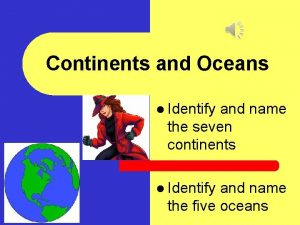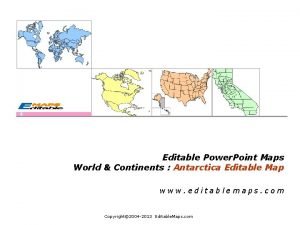Continents and Oceans Passport to Geography Physical maps

- Slides: 1

Continents and Oceans Passport to Geography Physical maps show height. On this map, green is lower land orange/brown is higher land. In the UK, the upland areas are found in the north and west. For example, many part of Scotland. The lowland areas are found in the south and east. For example, East Anglia. Types of Geography Human Geography The study of how and where people live. Physical Geography The study of the Earth’s natural features (e. g. rivers) and events (e. g. earthquakes). Environmental Geography The study of the relationship between the physical and human environment. Latitude and Longitude Latitude Lines around the earth to help us find places north or south of the equator. Longitude Lines down the earth to help us find places east or west of the Greenwich Meridian. Always give north/south first, then east/west. For example, Sunderland is 54°N 1°W. In the UK, the most densely populated parts are towards the south and central areas, where the land is lower. The most sparsely populated areas are the mountainous areas like Wales and parts of Scotland. Why might these areas be considered spectacular? Why do lots of people visit places like the Lake District? How do they affect where we live? Human Geography Choropleth maps use colour to show data. This helps us to see patterns. On this map, the darker the colour the more densely populated the area is. The British Isle has a multicultural society. Migration has shaped and changed the population. Migration makes a contribution to Migration helps create a the economy and helps multicultural society. meet the neds we have Migration has been in certain job sectors encouraged by the UK in such as the NHS and low the past, for example paid manual jobs. after WW 2 when we relied on migration to support the rebuilding programme. Key words Relief – the height and shape (steepness) of the land. We say how high somewhere is above sea level. Densely populated – an area with a lot of people living there. Sparsely populated – an area with lower numbers of people living there. You need to be able to identify the location of the capital cities of the 5 countries of the British Isles on a map. Ordnance Survey (OS) Maps Direction on a map is shown by a compass. On an OS map, north is always straight up (the top of the map) Contour lines are used to show height. They join up areas of equal height. The closer the contour lines are together, the steeper the slope is. Scale is used to show distance on a map. Use a ruler to measure the distance from one point to another then move the ruler to the scale line and read off the distance. Grid references help us find places on an OS map. 4 figure – find the number along the bottom of the map, then up the side. You need to look for the bottom left corner of the square. More support for your revision is available at… BBC Bitesize KS 3 revision http: //www. ordnancesurvey. co. uk/mapzone/ - map skill focused Seneca Learning – KS 3 Geography (revision quizzes organised by topic)

